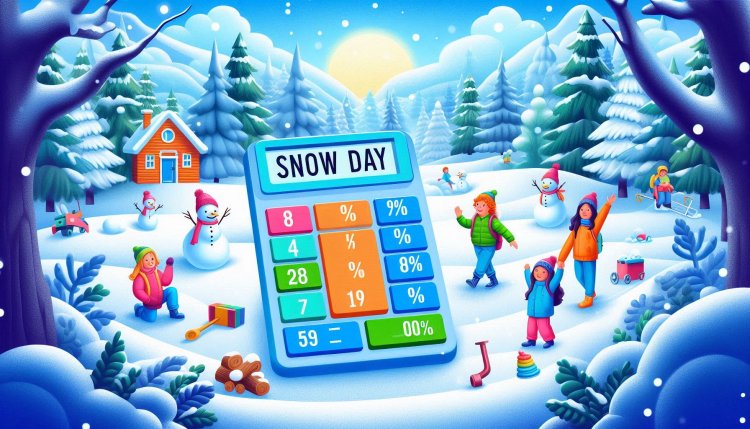Free Snow Day Calculator: Your Ultimate Guide to Predicting Snow Days
Discover how a Free Snow Day Calculator can help you predict school closures due to snow. Learn how it works, why it’s useful, and the best tools to try.
Snow days are a cherished part of winter for students, parents, and even teachers. The anticipation of waking up to a blanket of snow and the announcement that school is closed is a thrill like no other. But how can you predict when a snow day might happen? Enter the Free Snow Day Calculator, a tool that has become increasingly popular for forecasting the likelihood of school closures due to snow. In this comprehensive guide, we’ll explore what a snow day calculator is, how it works, and why it’s become an essential tool for families during the winter months.
What is a Free Snow Day Calculator?
A Free Snow Day Calculator is an online tool designed to predict the probability of school cancellations due to snow, ice, or extreme winter weather. By analyzing various factors such as current weather conditions, forecasts, and historical data, these calculators provide users with an estimate of whether or not schools in their area are likely to close.
The concept of a snow day calculator was popularized by a high school student named David Sukhin, who created the first version in 2007. Since then, the tool has evolved, incorporating more advanced algorithms and data sources to improve accuracy. Today, there are several free snow day calculators available online, each offering unique features and insights.
How Does a Snow Day Calculator Work?
Snow day calculators use a combination of data points and algorithms to make their predictions. Here’s a breakdown of the key factors they consider:
1. Weather Forecasts
The primary input for any snow day calculator is the weather forecast. This includes data on expected snowfall amounts, temperature, wind speed, and precipitation type (snow, sleet, or freezing rain). The calculator analyzes this information to determine how severe the weather is likely to be.
2. Historical Data
Many snow day calculators use historical data to improve their predictions. By looking at past school closures and the weather conditions that caused them, the tool can identify patterns and trends. For example, if schools in your area typically close when snowfall exceeds 6 inches, the calculator will factor this into its prediction.
3. School District Policies
Different school districts have varying policies when it comes to snow days. Some may close at the first sign of snow, while others wait until conditions become hazardous. A good snow day calculator takes these policies into account, often allowing users to select their specific school district for more accurate results.
4. Real-Time Updates
Some advanced snow day calculators offer real-time updates, pulling in the latest weather data and adjusting their predictions accordingly. This ensures that users get the most up-to-date information possible.
5. User Input
Many calculators allow users to input additional details, such as their location, school district, and current weather conditions. This personalized approach helps improve the accuracy of the predictions.
Why Use a Free Snow Day Calculator?
There are several reasons why a free snow day calculator has become a go-to tool for families during the winter:
1. Convenience
Instead of constantly checking the weather forecast or waiting for an official announcement, a snow day calculator provides a quick and easy way to gauge the likelihood of a school closure. This can save time and reduce stress for parents and students alike.
2. Planning Ahead
Knowing the probability of a snow day allows families to plan ahead. Whether it’s arranging childcare, adjusting work schedules, or simply preparing for a day of fun in the snow, having advance notice can make a big difference.
3. Fun and Excitement
For students, the anticipation of a snow day is half the fun. Using a snow day calculator adds an element of excitement, as they eagerly check the predictions and hope for a day off.
4. Community Engagement
Snow day calculators often include features that allow users to share their predictions and compare results with others in their area. This fosters a sense of community and adds to the overall experience.
Top Free Snow Day Calculators to Try
If you’re interested in trying out a snow day calculator, here are some of the best free options available online:
1. Snow Day Calculator by David Sukhin
The original and most well-known snow day calculator, created by David Sukhin, remains a popular choice. It uses a simple interface and provides a percentage chance of a snow day based on your location and current weather conditions.
2. Snow Day Predictor
This calculator offers a more detailed analysis, taking into account factors such as wind chill and road conditions. It also allows users to select their specific school district for more accurate predictions.
3. Weather.com Snow Day Forecast
Weather.com’s snow day forecast tool integrates with their comprehensive weather data, providing real-time updates and detailed forecasts. It’s a great option for those who want the most up-to-date information.
4. Local News Websites
Many local news stations and websites offer their own snow day calculators, tailored to the specific weather patterns and school policies in your area. These can be particularly useful for getting hyper-local predictions.

Tips for Using a Snow Day Calculator
To get the most out of your snow day calculator experience, keep these tips in mind:
1. Check Multiple Sources
While snow day calculators are generally reliable, it’s always a good idea to check multiple sources for the most accurate prediction. Compare results from different calculators and cross-reference them with official weather forecasts.
2. Input Accurate Information
Make sure to provide accurate details when using a snow day calculator. This includes your exact location, school district, and current weather conditions. The more precise your input, the more accurate the prediction will be.
3. Stay Updated
Weather conditions can change rapidly, so be sure to check the calculator regularly for updates. Some tools offer real-time updates, while others may require manual refreshing.
4. Have a Backup Plan
While snow day calculators are helpful, they’re not foolproof. Always have a backup plan in case the prediction is wrong and school remains open.
The Science Behind Snow Day Predictions
Predicting snow days isn’t just about guessing—it’s a science. Meteorologists and data scientists use complex algorithms and models to analyze weather patterns and predict outcomes. Here’s a closer look at the science behind snow day predictions:
1. Meteorological Models
Meteorologists use computer models to simulate weather conditions and predict how they will evolve over time. These models take into account factors such as temperature, humidity, wind speed, and atmospheric pressure.
2. Probability Analysis
Snow day calculators often use probability analysis to determine the likelihood of a school closure. By analyzing historical data and current conditions, they can assign a percentage chance to the event.
3. Machine Learning
Some advanced snow day calculator incorporate machine learning algorithms, which improve their accuracy over time by learning from past predictions and outcomes.
The Impact of Climate Change on Snow Days
As climate change continues to affect weather patterns, the frequency and severity of snow days may also change. Warmer temperatures could lead to fewer snow days in some regions, while others may experience more extreme winter weather events. This makes tools like the snow day calculator even more valuable, as they help families adapt to changing conditions.
Conclusion
A Free Snow Day Calculator is more than just a fun tool—it’s a practical resource for families navigating the challenges of winter weather. By providing accurate predictions and real-time updates, these calculators help parents and students plan ahead and make the most of their snow days. Whether you’re hoping for a day off or just want to stay informed, a snow day calculator is a must-have tool for the winter season.
What's Your Reaction?






















.jpg)